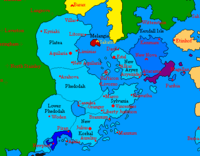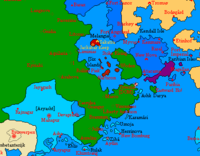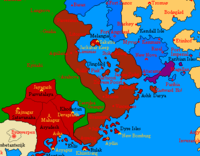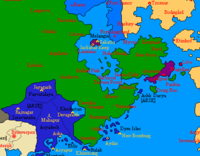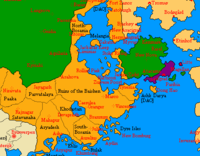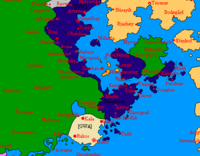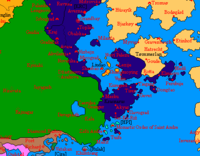Çakaristan
| Ultimate Çakar Sultanate سلطنة شاكار النهائية Saltanat Shakar al-Nihayiya | |||
| |||
| Motto: There is no god, but Craitgod لا إله إلا كريت إله la 'iilah 'iilaa kurit 'iilah | |||
| Anthem: Azeem-o-shaan shahenshah अज़ीम-ओ-शान शहंशाह O majestic and noble emperor | |||
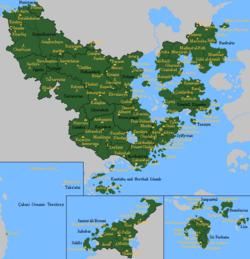
| |||
| Map versions | 17.0.3 - current | ||
| Capital | Agra | ||
| Largest city | Manbai | ||
| Official language(s) | Arboric | ||
| Official religion(s) | Craitism | ||
| Demonym | Çakari | ||
| - Adjective | |||
| Government | Hereditary monarchy | ||
| - Sultan سلطان | Akbar Çakar | ||
| - Grand vizier وزیر اعظم | Rajesh Avchat | ||
| - Legislature | Majlis al-Sultina مجلس السلطنة | ||
| Establishment | 1687 AN | ||
| Area | |||
| Population | |||
| Active population | 1 | ||
| Currency | Gold dinar ﺩﻳﻨﺎﺭ ذهبي | ||
| Calendar | |||
| Time zone(s) | CMT, CMT+1, CMT+1:30 and CMT+2 | ||
| Mains electricity | |||
| Driving side | left | ||
| Track gauge | |||
| National website | |||
| National forum | |||
| National animal | White tiger | ||
| National food | |||
| National drink | |||
| National tree | |||
| Abbreviation | CKR, CK | ||
Çakaristan (/t͡ʃɑːˈkɑːɾi:stɑːn/), officially the Ultimate Çakar Sultanate (Arboric: سلطنة شاكار النهائية; Aryashti: परम आकर सल्तनत), is a sovereign state in the southeastern continent of Apollonia. The official name of the sultanate was chosen at the second major meeting in Red Fortress; before that, Sylvania was the working title for the sultanate. The ceremonial name for the sultanate is Hilal Empire (Arboric: امبراطورية هلال), which means Empire of the Cresent Moon. Less in use is the short name: Çakar Empire.
The state has a hereditary monarchy, but it has no constitution. The capital and seat of government is Agra.
As a state, Çakaristan is for the most part on the mainland of Apollonia, including its capital and on Kendall Isle. The mainland peninsula separates the Antican Sea and Herrin Bay, which is part of the Orange Sea.
Etymology
The full name of the nation is made up of three components:
- The sultanate is "ultimate" because it is located on Apollonia. The name "Apollonia" means "ultimate", which means that the inhabitants of the continent consider themselves ultimate;
- The name "Çakar" comes from the sultan's family name;
- The monarch was crowned "sultan" because of his background in Craitism.
The name of Çakaristan in several languages:
| Language | Status | Short form | Long form | Transliteration |
|---|---|---|---|---|
| Arboric | Official | شاكارستان | سلطنة شاكار النهائية | Saltanat Shakar al-Nihayiya |
| Aryashti | Official | चमकतास्टेन | परम आकर सल्तनत | Param Aakar Saltanat |
| Babkhi | Regional | چاکارستان | سلطنت نهایی چاکار | sltnt nhaaa oklar |
| Catologian | Official | Çakaristan | Ultimum Çakar Sultanate | none |
| Common tongue | Official | Çakaristan | Ultimate Çakar Sultanate | none |
History
Ancient Çakaristan
Thousands of years ago there was habitation and civilisation in what is now Çakaristan. This is evidenced by various archaeological finds and remnants of ancient forts. Only after the foundation of the Ultimate Çakar Sultanate is a study made of this rich history.
Modern Era
It is difficult to classify the period after 1440 AN to the foundation of the sultanate under one denominator. But because of the major changes not to assign it to an important period and the corresponding denominator.
The first mention of habitation in the territory of the present sultanate is under the flag of the Free Republic. In 1468 AN, the Republic of Baracão was established, its territory being referred to as Red Island. Shortly this republic was replaced by Freenesia. After the fall of the latter nation, the territory was reduced to the green. At the end of the 15th century the area came under the flag of Emirate of Baatharz, shortly before this nation was taken over by the Kingdom of Babkha. The north of the sultanate was under the flag of Dinarchy of Antica with the name Phedodah.
In 1498 AN the Babkhaan territory on Apollonia briefly came under the flag of Crusader State of Eblis. At the beginning of the 15th century Antica was incorporated into Imperial Republic of Shireroth, as a result of which Phedodah bordered on the Babkhaan province Terre d'Riches. Until the Republic of Antica regained its independence in the second decade of the 16th century. The areas of Phedodah and Terre d'Riches came under the Antican flag, except for the coastal islands which remained under Babkhaan flag. Between 1514 and 1519 the peninsula and the coastal islands were abandoned. In 1519 the earlier Terre d'Riches again came under the Antican flag and became part of Lower Phedodah.
In 1597 AN the territory of the sultanate was abandoned except for a few border areas, the Empire of Aryasht came into being. Not much later the coastal islands were reclaimed. In 1607 AN Aryasht became part of Shireroth. In the same year a large part of the territory of present-day Sylvania became a nation: Jingdao. This nation left the area in 1613 AN.
In 1619 AN Aryasht became part of the Apollonian Republic of Shireroth's East, which became the Empire of the Great Jing. Jingdao also claimed the peninsula in 1630 AN and retained the area for two Norton years. On a few exclaves the area was left to the green. This remained until 1650 AN with the foundation of the Khanate of Krasnarus. The western boundary of the khanate still determines the subdivision of the sultanate. In 1691 AN, Krasnarus founded the Kingdom of Krasnocoria together with the neighbouring Kingdom of Coria.
Between 1680 and 1685 a civil war raged on the peninsula, the Hasani War. This civil war is seen by many as a prelude to the later Sylvanian National Awakening.
Çakari Era
On the eve of the collapse of Krasnocoria, unrest arose in Krasnarus between the different population groups. Representatives of the Coriaks, Hasanis and Nogans united to fight for independence. There was also support from the green and from the Emirate of Arbor. This uprising was called the Sylvanian National Awakening. On 4.XIII.1688 AN the uprising was officially ended and the sultanate proclaimed. Since there was no agreement on a constitution, only a sultan was elected: Abu Çakar. He was given the crown name "Akbar".
Less than an hour after his coronation as Sultan, an assassination attempt was made on Akbar. Fortunately, the sultan survived the attack, but a Grand Vizier was appointed to start the government of the nation.
At the second major meeting in Red Fortress, it was decided to establish the name of the nation. Until then, "Sylvania" was used, a name for the area from the Antican period. That name means "from the forest" in Catologian, referring to the streams and rivers that flow from the densely forested highlands. The name of the nation was chosen: Çakaristan.
Government
Sultan
The sultan is the head of state and defacto the absolute ruler of Çakaristan. He represents the sultanate, signs the laws and appoints government officials.
The first sultan was elected by the meeting in which the foundation of the nation was laid and the war for independence officially ended. Abu Çakar was elected sultan and was given the title Akbar (great). On the same day, the sultan married Jodha Avchat, adding Phedodah, which had fallen into the green, to the sultanate.
Because an assassination attempt was made on the sultan within hours of his coronation, a Grand Vizier was appointed. He led the government during the Sultan's recovery.
Grand Vizier
The first Grand Vizier was designated by the Founding Meeting, in order to avoid a possible later succession battle, the meeting did not choose one of the sultan's brothers. The sultan's father-in-law was appointed: Rajesh Avchat.
Administrative divisions
Çakaristan is divided into a national district, 3 princely states and 10 subahs. The District of Apollonia is a national district which contains the capital of Çakaristan, Agra, which means that the capital is also referred to as Agra, D.A.
The Çakaristan heartland comprising the territory on the Apollonia peninsula between the Antican Sea and Herrin Bay, including its coastal islands, is divided into subahs. To the west, the green border separates the subahs from the princely states. The green border is the former western border of the Khanate of Krasnarus with the exception of Phedodah. The boundaries of the subahs are almost identical to the districts of Krasnarus. The governor of a Subah is called a "Subahdar". A Subahdar is appointed by the Sultan. Each subah has its own parliament in addition to a governor.
| Seal | Subah | Subahdar | Capital |
|---|---|---|---|
 |
Ardnusur | Yassin al-Azimi | Merku |
 |
Faliwrid | Hakeem el-Kanan | Kuribad |
 |
Gevet | Jawhar al-Khalili | Hiawatha |
 |
Hasanistan | Farooq al-Farhat | Šer-Ku-Riž |
 |
Kurjek | Ashraf al-Mahdi | Shahr |
 |
Micobad | - | Micobad |
 |
Noganistan | Faouzi el-Shaker | Akyar |
 |
Salafulanid | Damra al-Huq | Salafubad |
 |
Suqutra | - | Suqutra |
 |
Tuife | - | Tuife |
The princely states have a large degree of autonomy within the sultanate. The head of a princely state must swear allegiance to the sultan, with the sultan giving his blessing to that head of state. The further organisation of the state is regulated separately for each princely state.
| Flag | Princely state | Ruler | Capital |
|---|---|---|---|
| Khanate of Jabal al-Mada' | Amir Çakar | Lyzij | |
| Poorajangal Rajya | Rajesh Avchat | Liburnia | |
| Korhalistan Rajya | Hasan Çakar | Çakarabad |





